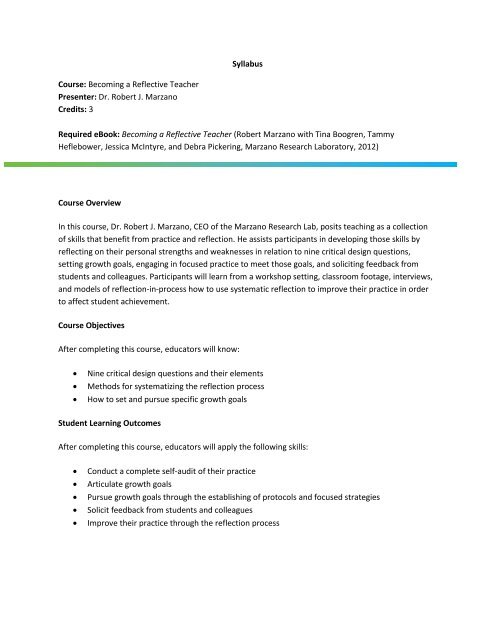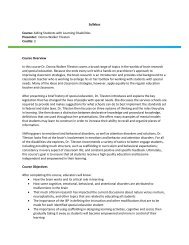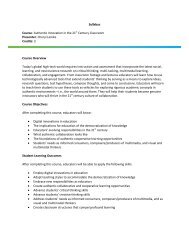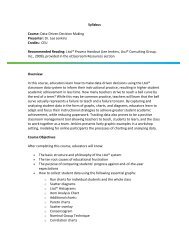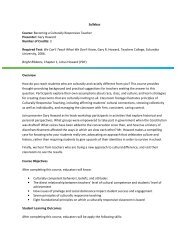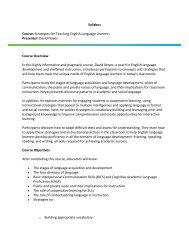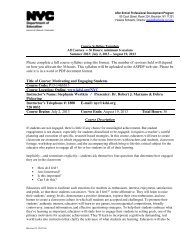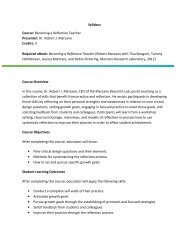Becoming a Reflective Teacher Presenter: Dr. Robert J. Marzano ...
Becoming a Reflective Teacher Presenter: Dr. Robert J. Marzano ...
Becoming a Reflective Teacher Presenter: Dr. Robert J. Marzano ...
You also want an ePaper? Increase the reach of your titles
YUMPU automatically turns print PDFs into web optimized ePapers that Google loves.
SyllabusCourse: <strong>Becoming</strong> a <strong>Reflective</strong> <strong>Teacher</strong><strong>Presenter</strong>: <strong>Dr</strong>. <strong>Robert</strong> J. <strong>Marzano</strong>Credits: 3Required eBook: <strong>Becoming</strong> a <strong>Reflective</strong> <strong>Teacher</strong> (<strong>Robert</strong> <strong>Marzano</strong> with Tina Boogren, TammyHeflebower, Jessica McIntyre, and Debra Pickering, <strong>Marzano</strong> Research Laboratory, 2012)Course OverviewIn this course, <strong>Dr</strong>. <strong>Robert</strong> J. <strong>Marzano</strong>, CEO of the <strong>Marzano</strong> Research Lab, posits teaching as a collectionof skills that benefit from practice and reflection. He assists participants in developing those skills byreflecting on their personal strengths and weaknesses in relation to nine critical design questions,setting growth goals, engaging in focused practice to meet those goals, and soliciting feedback fromstudents and colleagues. Participants will learn from a workshop setting, classroom footage, interviews,and models of reflection-in-process how to use systematic reflection to improve their practice in orderto affect student achievement.Course ObjectivesAfter completing this course, educators will know:Nine critical design questions and their elementsMethods for systematizing the reflection processHow to set and pursue specific growth goalsStudent Learning OutcomesAfter completing this course, educators will apply the following skills:Conduct a complete self-audit of their practiceArticulate growth goalsPursue growth goals through the establishing of protocols and focused strategiesSolicit feedback from students and colleaguesImprove their practice through the reflection process
Unit 1: Research and TheoryIn this unit, <strong>Dr</strong>. <strong>Robert</strong> J. <strong>Marzano</strong> establishes why teachers should systematically reflect on theirpractice. He reviews the history of reflection, as well as the supporting research, and elicits from theworkshop participants their experience with reflection and its benefits for them and their students.Unit ObjectivesAfter completing this unit, educators will know:The history of reflective practiceThe research that supports reflective practiceThe benefits of reflective practiceStudent Learning OutcomesAfter completing this unit, educators will apply the following skills:Support the practice of reflectionAnalyze the strengths and weaknesses of their reflective practices to dateeBook: “Research and Theory”Participants read chapter 1, “Research and Theory,” in their eBook and respond to reflection prompts.Unit 2: Routine and Content Strategies and BehaviorsIn this unit, <strong>Dr</strong>. <strong>Robert</strong> J. <strong>Marzano</strong> and the workshop participants delve into the nine critical designquestions that can inform teachers’ reflective practice. They explore how to reflect on routine eventsand learning content.Unit ObjectivesAfter completing this unit, educators will know:The first five critical design questions and their elementsStudent Learning Outcomes
After completing this unit, educators will apply the following skills:Reflect on their practice by answering these questions:o What will I do to establish and communicate learning goals, track student progress,and celebrate success?o What will I do to establish and maintain classroom rules and procedures?o What will I do to help students effectively interact with new knowledge?o What will I do to help students practice and deepen their understanding of newknowledge?o What will I do to help students generate and test hypotheses about newknowledge?Unit 3: On-the-Spot Strategies and BehaviorsIn this unit, <strong>Dr</strong>. <strong>Robert</strong> J. <strong>Marzano</strong> and the workshop participants study the four remaining critical designquestions. They consider how to reflect on their on-the-spot behaviors.Unit ObjectiveAfter completing this unit, educators will know:The four remaining critical design questions and their elementsStudent Learning OutcomesAfter completing this unit, educators will apply the following skills:Reflect on their practice by answering these questions:o What will I do to engage students?o What will I do to recognize and acknowledge adherence or lack of adherence torules and procedures?o What will I do to establish and maintain effective relationships with students?o What will I do to communicate high expectations for all students?eBook: “Having a Model of Effective Teaching”Participants read chapter 2, “Having a Model of Effective Teaching,” in their eBook and respond toreflection prompts.
Unit 4: Setting Growth GoalsIn this unit, participants consider their practice in relation to three stages of progress: cognitive, shaping,and autonomous. They learn to assess different skills as beginning, developing, applying, andinnovating, finally conducting a complete self-audit that leads to the articulation of specific growthgoals.Unit ObjectivesAfter completing this unit, educators will know:The cognitive, shaping, and autonomous phrases of their practiceWhere to modify their practice to progress from beginning to developing to applying toinnovatingThe parameters of growth goalsStudent Learning OutcomesAfter completing this unit, educators will apply the following skills:Assess aspects of their practice as being in the cognitive, shaping, or the autonomous phaseAssess aspects of their practice from beginning to innovatingConduct a complete self-auditEstablish growth goalseBook: “Growth Goals”Participants read chapter 3, “Setting Growth Goals,” in their eBook and respond to reflection prompts.Unit 5: Engaging in Focused PracticeIn this unit, <strong>Dr</strong>. <strong>Robert</strong> J. <strong>Marzano</strong> and participants explore the processes that lead to achievement ofgrowth goals. They discuss how to determine protocols and pursue specific strategies.Unit ObjectiveAfter completing this unit, educators will know:Processes by which to achieve growth goals
Student Learning OutcomesAfter completing this unit, educators will apply the following skills:Establish protocols to help them achieve their growth goalsFocus on particular strategies relevant to their growth goalseBook: “Focused Practice”Participants read chapter 4, “Engaging in Focused Practice,” in their eBooks and respond to reflectionprompts.Unit 6: Receiving Focused FeedbackIn this unit, <strong>Dr</strong>. <strong>Robert</strong> J. <strong>Marzano</strong> assists participants in developing methods for gathering focusedfeedback on their practice through such strategies as student surveys and the analysis of student data.Unit ObjectiveAfter completing this unit, educators will know:Assorted methods for receiving focused feedbackStudent Learning OutcomesAfter completing this unit, educators will apply the following skills:Develop student surveysAnalyze student dataeBook: “Focused Feedback”Participants read chapter 5, “Receiving Focused Feedback,” in their eBooks and respond to reflectionprompts.
Unit 7: Observing and Discussing TeachingIn this unit, <strong>Dr</strong>. <strong>Robert</strong> J. <strong>Marzano</strong> and participants explore different methods for observing anddiscussing teaching, including interacting around videos, creating coaching-colleagues relationships, andfacilitating instructional rounds.Unit ObjectiveAfter completing this unit, educators will know:Different methods for facilitating observation and discussion of teachingStudent Learning OutcomesAfter completing this unit, educators will apply the following skills:Have productive conversations about teaching using videos as a sourceCreate coaching-colleagues relationshipsStructure instructional roundseBook: “Observation and Discussion”Participants read chapter 6, “Observing and Discussing Teaching,” in their eBook and respond toreflection prompts.Unit 8: Facilitated ReflectionIn this unit, <strong>Dr</strong>. <strong>Robert</strong> J. <strong>Marzano</strong> and his colleague Tina Boogren assist the workshop participants inreflecting on their practice by debriefing video segments of their teaching in practice. They discusswhere in the teacher’s practice they see alignment to the elements of the nine critical design questionsand where there might be room for growth.Unit ObjectiveAfter completing this unit, educators will know:What reflection-in-action can look likeStudent Learning Outcome
After completing this unit, educators will apply the following skills:Deepen and extend their reflection practice<strong>Presenter</strong>’s Bio<strong>Dr</strong>. <strong>Robert</strong> J. <strong>Marzano</strong> is the cofounder and CEO of <strong>Marzano</strong> Research Laboratory in Denver, Colorado.Throughout his forty years in the field of education, he has become a speaker, trainer, and author ofmore than thirty books and 150 articles on topics such as instruction, assessment, writing, andimplementing standards, cognition, effective leadership, and school intervention. His books include: TheArt and Science of Teaching: A Comprehensive Framework for Effective Instruction, Making StandardsUseful in the Classroom, District Leadership That Works: Striking the Right Balance, Designing andTeaching Learning Goals and Objectives, and On Excellence in Teaching. His practical translations of themost current research and theory into classroom strategies are internationally known and widelypracticed by both teachers and administrators. He received a bachelor’s degree from Iona College inNew York, a master’s degree from Seattle University, and a doctorate from the University ofWashington.Methods of Instruction:Videos (presentations consisting of lecture, interviews, and classroom footage)Text (units based on required reading)Reflection questions (open-ended questions at intervals throughout the video presentationswhere participants are asked to reflect on the course content, their own practice, and theirintentions for their practice)Quizzes (selected-response quizzes to assess understanding of the video presentations andeBook content)Discussion forum (prompts after each unit that engage participants in online dialogue with theircohorts)Midterm (a project intended to get teachers to begin to develop their practice by putting towork what they have learned)Final (a project that enables educators to reflect on their practice and assess their students’work through the lens of what they have learned)In order to complete the requirements of the course, the participant must complete all course work(e.g., reflections, quizzes, and any midterm and/or final), including watching all videos andparticipating in all discussion forums. We do not award partial credit.
Percentage of Course Credit Reflection questions 25% Quizzes 15% Midterm 25% Final 35%Plagiarism PolicyKDS recognizes plagiarism as a serious academic offense. Plagiarism is the passing off of someone else’swork as one’s own and includes failing to cite sources for others’ ideas, copying material from books orthe Internet (including lesson plans and rubrics), and handing in work written by someone other thanthe participant. Plagiarism will result in a failing grade and may have additional consequences. For moreinformation about plagiarism and guidelines for appropriate citation, consult plagiarism.org.A: 3.4 – 4.0B: 2.7 – 3.3C: 2.0 – 2.6F:
Participant hascopied from thecourse transcriptwithout synthesis oranalysisMidtermFor your midterm, you will choose one of the critical design questions to reflect so as to develop aspecific growth goal.Please do the following:1. Choose one critical design question.2. Flesh out in as much detail as possible all that you do in the classroom—both strategies andbehaviors—that align with that question.3. Choose two to three elements from that design question and describe your practice in relationto them.4. Explain why you designate your practice as either in the cognitive or the shaping stage.5. Explain how you are either beginning or developing in relation to the above. Be sure to refer to<strong>Dr</strong>. <strong>Marzano</strong>’s descriptors for each category.6. Identify your specific growth goal.Midterm RubricStep Distinguished (4) Proficient (3) Basic (2) Unsatisfactory (1)Choose one criticaldesign question.Flesh out in as muchdetail as possible allthat you do in theclassroom—bothstrategies andbehaviors—thatalign with thatquestion.Choose 2-3 elementsfrom that designquestion anddescribe yourpractice in relationto them.Participant hasfleshed out insignificant detail,with supportingexamples, his or herstrategies andbehaviors that alignwith one criticaldesign question.Participant hasdescribed in detailwith supportingexamples his or herpractice in relationto 2-3 elements.Participant hasfleshed out in somedetail his or herstrategies andbehaviors that alignwith one criticaldesign question.Participant hasdescribed his or herpractice in relationto 2-3 elements.Participant hasdescribed his or herstrategies andbehaviors that alignwith one criticaldesign question butwithout sufficientdetail.Participant has listedaspects of his or herpractice that relateto 1-2 elements.Participant haseither not describedboth strategies andbehaviors that alignwith one criticaldesign question noroffered anysupporting detail.Participant has listed0-1 aspects of his orher practice thatrelate to 0-1elements.
Explain why youdesignate yourpractice as either inthe cognitive orshaping stage.Explain how you areeither beginning ordeveloping inrelation to theabove. Be sure torefer to <strong>Dr</strong>.<strong>Marzano</strong>’sdescriptors for eachcategory.Identify your specificgrowth goal.Formal issuesParticipant hasexplained withsupporting exampleshow his or herpractice is in eitherthe cognitive orParticipant has used<strong>Dr</strong>. <strong>Marzano</strong>’scategory descriptors,supported byexamples, to explainhow he or she isbeginning ordeveloping inrelation to particularelements of his orher practice.Participant hasidentified a specific,clearly relevantgrowth goal.Participant has madeno grammaticalerrors.Participant hasexplained how his orher practice is ineither the cognitiveor shaping stage.Participant has used<strong>Dr</strong>. <strong>Marzano</strong>’scategory descriptorsto explain how he orshe is beginning ordeveloping inrelation to particularelements of his orher practice.Participant hasidentified a specificgrowth goal.Participant has madea few grammaticalerrors.Participant hasindicated, thoughnot wholly clearly,how his or herpractice is in eitherthe cognitive orshaping stage.Participant hasindicated how he orshe is beginning ordeveloping inrelation to particularelements of his orher practice thoughhas not incorporated<strong>Dr</strong>. <strong>Marzano</strong>’slanguage nor beenespeciallypersuasive.Participant hasidentified a vaguegrowth goal.Participant has madesome distractinggrammatical errors.Participant has notindicated how his orher practice is ineither the cognitiveor shaping stage.Participant has notindicated how he orshe is beginning ordeveloping inrelation to particularelements of his orher practice.Participant has notidentified a growthgoal.Participant has mademultiplegrammatical errors.Participant hasorganizedparagraphs aroundclearly articulatedmain ideas.Participant haswritten in aneffective andeloquent style—i.e.,has varied his or hersentence structureand made carefulword choice.Participant hasorganized mostparagraphs aroundclearly articulatedmain ideas.Participant haswritten in aneffective andeloquent style—i.e.,has varied his or hersentence structurethough not alwaysfound the rightword.Participant hasorganized mostparagraphs aroundclearly articulatedmain ideas.Participant haswritten in aneffective andeloquent style—i.e.,has varied his or hersentence structurethough not alwaysfound the rightword.Paragraphs are notorganized aroundmain ideas.Participant haswritten in a stylethat does noteffectivelycommunicate his orher thoughts.FinalFor your midterm, you went through a process that helped you articulate a specific growth goal. Now,your objective is to determine what the protocol should be to achieve that goal; what strategy,
strategies, or macrostrategy you will focus on; and where—in addition to a student survey—you will getfeedback on your efforts to pursue your goal.Please do the following:1. Reiterate your growth goal and describe why you chose to focus on it.2. Outline the steps of an appropriate protocol that will help you achieve your goal. Include adescription of the specific strategy, strategies, or macrostrategy you intend to implementtoward achieving your goal.3. Design and present a student survey with at least five (5) questions that will give you feedbackon your progress.4. Choose one strategy for pursuing feedback from your colleagues—e.g., from videos, coachingcolleagues, or instructional rounds—and explain why you would choose that method.Final RubricStep Distinguished (4) Proficient (3) Basic (2) Unsatisfactory (1)Reiterate yourgrowth goal andParticipant hasclearly summarizedParticipant hassummarized theParticipant hasattempted toParticipant has notattempted todescribe why you the growth goal growth goalsummarize the summarize theidentified in the identified in the growth goalgrowth goalchose to focus on it.midterm.midterm.identified in the indentified in themidtermmidterm.Outline the steps ofan appropriateprotocol that willhelp you achieveyour goal.Then detail thespecific strategy,strategies, ormacrostrategy youintend to implementtoward achievingyour goal.The explanation forthe choice of thegrowth goal is clearand appropriate.Participant hasoutlined a clear andpurposeful protocolto achieve his or hergoal.Participant hasdetailed a clearlyappropriate andefficient strategy,strategies, ormacrostrategy he orshe intends toimplement towardachieving his or hergoal.The participantexplains the choiceof the growth goal.Participant hasoutlined anappropriate protocolto achieve his or hergoal.Participant hasdetailed a specificstrategy, strategies,or macrostrategy heor she intends toimplement towardachieving his or hergoal.The explanation forthe choice of thegrowth goal issomewhat unclear.Participant hasindicated a protocolto achieve his or hergoal, but it is notevident that theprotocol isappropriate.Participant hasindicated, thoughwithout supportingdetail, a strategy,strategies, ormacrostrategy he orshe intends toimplement towardachieving his or hergoal.Participant has notindicated a protocolto achieve his or hergoal.Participant has notindicated a strategy,strategies, ormacrostrategy he orshe intends toimplement towardachieving his or hergoal. Or, participanthas indicated aninappropriatestrategy, strategies,or macrostrategy todo so.
Design and present astudent survey withat least 5 questionsthat will give youfeedback on yourprogress.Choose one strategyfor pursuingfeedback from yourcolleagues—e.g.,from videos,coaching colleagues,or instructionalrounds—and explainwhy you wouldchoose that method.Formal issuesParticipant hasdesigned andpresented apotentiallyilluminating studentsurvey with at least5 questions.Participant haspersuasively argued,with supportingdetail, his or herchoice of a methodfor pursuingfeedback fromcolleagues.Participant has madeno grammaticalerrors.Participant hasdesigned andpresented a studentsurvey with at least5 questions.Participant hasexplained his or herchoice of a methodfor pursuingfeedback fromcolleagues.Participant has madea few grammaticalerrors.Participant hasdesigned andpresented a studentsurvey with fewerthan 5 not clearlyappropriatequestions.Participant hasindicated his or herchoice of a methodfor pursuingfeedback fromcolleagues butwithout adequateexplanation.Participant has madesome distractinggrammatical errors.Participant has notdesigned orpresented a studentsurvey withappropriatequestions.Participant has notindicated his or herchoice of a methodfor pursuingfeedback fromcolleagues.Participant has mademultiplegrammatical errors.Participant hasorganizedparagraphs aroundclearly articulatedmain ideas.Participant haswritten in aneffective andeloquent style—i.e.,has varied his or hersentence structureand made carefulword choice.Participant hasorganized mostparagraphs aroundclearly articulatedmain ideas.Participant haswritten in aneffective andeloquent style—i.e.,has varied his or hersentence structurethough not alwaysfound the rightword.Participant hasorganized mostparagraphs aroundclearly articulatedmain ideas.Participant haswritten in aneffective andeloquent style—i.e.,has varied his or hersentence structurethough not alwaysfound the rightword.Paragraphs are notorganized aroundmain ideas.Participant haswritten in a stylethat does noteffectivelycommunicate his orher thoughts.


